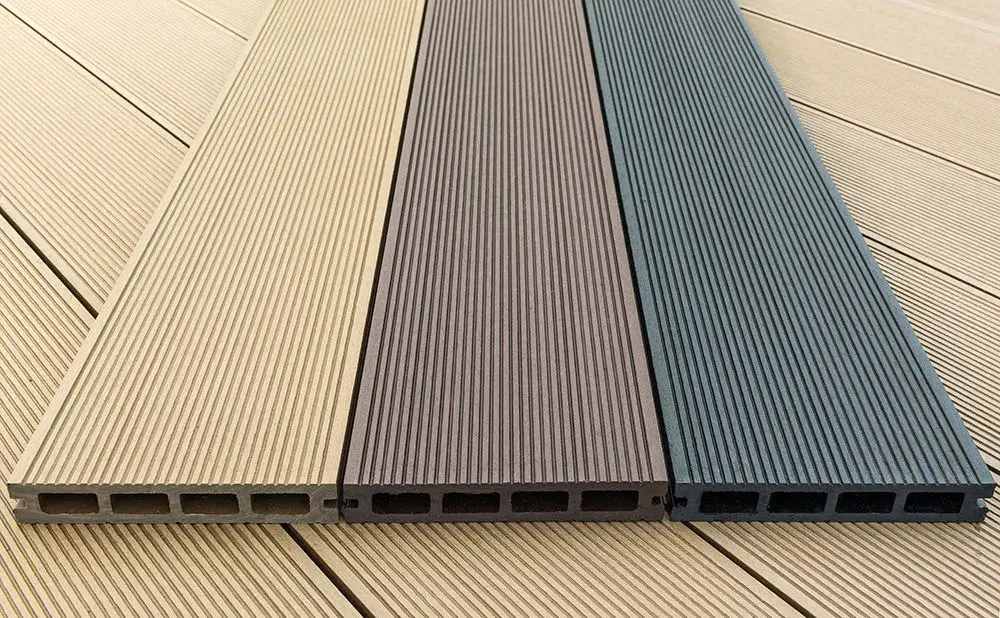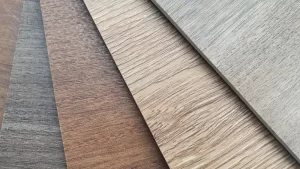When it comes to outdoor spaces, whether it’s a backyard oasis, a rooftop terrace, or a balcony retreat, the choice of flooring plays a pivotal role in creating an inviting and functional environment. Among the various options available, WPC deck flooring has gained significant popularity. WPC (Wood-Plastic Composite) deck flooring is a versatile and innovative material that has taken the outdoor flooring world by storm. It combines the natural beauty of wood with the durability and low-maintenance advantages of composite materials. WPC deck flooring is designed to withstand the harshest outdoor conditions, including extreme weather, UV rays, and moisture, without succumbing to common issues like warping, cracking, or fading. What sets it apart is its ability to mimic the rich aesthetics of real wood while offering enhanced longevity and sustainability. With its low maintenance requirements, eco-friendly attributes, and resistance to rot and pests, WPC deck flooring has become the go-to choice for homeowners and designers looking to create inviting and enduring outdoor spaces. In this blog post, we’ll delve into the world of WPC Deck Flooring, exploring its characteristics, benefits, installation process, and maintenance requirements.
What is WPC Deck Flooring?
WPC deck flooring stands for Wood-Plastic Composite deck flooring. It is a type of outdoor flooring material made by combining wood fibers or sawdust with thermoplastics, such as polyethylene, polyvinyl chloride (PVC), or polypropylene. This combination results in a composite material that offers the best of both worlds: the natural appearance of wood and the durability and low-maintenance qualities of plastic.
WPC deck flooring is specifically designed for use in outdoor settings, such as decks, patios, balconies, and pool areas. It is known for its ability to mimic the look and texture of real wood while providing several advantages over traditional wooden decking. Some key features and benefits of WPC deck flooring include:
- Durability
- Aesthetics
- Low Maintenance
- Eco-Friendly
- Resistance to Rot and Pests
WPC deck flooring has become a popular choice for homeowners and designers looking to create beautiful and long-lasting outdoor living spaces. It offers the benefits of natural wood aesthetics without the associated drawbacks, making it a practical and stylish option for outdoor flooring projects.
The Benefits of WPC Deck Flooring
WPC (Wood-Plastic Composite) deck flooring offers a wide range of benefits that make it a popular choice for outdoor flooring projects. Here are some of the key advantages of using WPC deck flooring:
- Durability: WPC deck flooring is highly durable and can withstand harsh outdoor conditions. It is resistant to moisture, UV rays, temperature fluctuations, and environmental factors that can cause traditional wood decking to warp, crack, or deteriorate over time. This durability ensures that your deck remains structurally sound for many years.
- Aesthetics: One of the standout features of WPC decking is its ability to mimic the natural beauty of wood. It comes in a variety of finishes, colors, and textures, allowing homeowners and designers to achieve the desired aesthetic for their outdoor space. Whether you prefer the look of exotic hardwoods or traditional wood grains, WPC decking can deliver.
- Low Maintenance: Unlike natural wood decking, WPC deck flooring requires minimal maintenance. It does not need to be stained, sealed, or sanded regularly to maintain its appearance. Occasional cleaning with mild soap and water is typically all that is needed to keep it looking pristine.
- Eco-Friendly: WPC is considered an environmentally friendly choice. It often incorporates recycled materials, reducing the demand for new timber and minimizing the environmental impact. Additionally, WPC does not contribute to deforestation and reduces the need for chemical treatments commonly used with natural wood products.
- Resistance to Rot and Pests: WPC is impervious to issues like rot, mold, and termite infestations, which are common problems with natural wood decking. This resistance ensures the longevity and structural integrity of the deck, eliminating the need for costly repairs and replacements.
- Versatility: WPC deck flooring is versatile and can be used in various outdoor settings, including decks, patios, balconies, and pool areas. Its adaptability makes it suitable for a wide range of design styles and preferences.
- Safety: Many WPC decking products are designed with safety in mind, featuring anti-slip surfaces that reduce the risk of accidents, especially in wet conditions.
- Longevity: Due to its durability and resistance to wear and tear, WPC deck flooring tends to have a longer lifespan than traditional wood decking, making it a cost-effective choice in the long run.
In conclusion, WPC deck flooring combines the best aspects of wood and plastic to offer a durable, aesthetically pleasing, low-maintenance, and environmentally friendly outdoor flooring solution. Whether you’re looking to create a beautiful deck, patio, or any other outdoor space, WPC decking is a compelling choice that stands up to the challenges of outdoor living.
Installation Process
The installation process for WPC (Wood-Plastic Composite) deck flooring is relatively straightforward, but it’s crucial to follow the manufacturer’s instructions and consider local building codes and regulations. Here’s a simplified overview of the typical steps involved in installing WPC deck flooring:
- Substructure Preparation: Before you begin installing WPC deck flooring, it’s essential to prepare a stable and level substructure. This substructure typically consists of treated lumber or steel joists that provide the necessary support for the deck boards.
- Frame Construction: Construct a sturdy frame for the deck using pressure-treated lumber. The frame should be designed to support the weight of the deck and any added loads, such as furniture and people. Ensure that the frame is level and properly anchored to the ground or the building structure.
- Joist Installation: Install joists perpendicular to the direction of the deck boards. The spacing between joists will depend on the manufacturer’s recommendations and local building codes. Typically, joists are spaced at 12 to 16 inches on center.
- Decking Installation: Now it’s time to install the WPC decking boards. Follow these steps:
- Start at one end of the deck and lay the first board with the proper orientation, usually with the grooved side facing the adjacent board.
- Leave a small gap (typically around 1/8 to 1/4 inch) between boards to allow for expansion and drainage.
- Secure the boards to the joists using stainless steel screws or concealed fasteners provided by the manufacturer. Make sure to drive the screws or fasteners at the recommended spacing along the joists.
- Continue installing boards row by row, ensuring they are straight and evenly spaced. Use a carpenter’s square or a chalk line to maintain alignment.
- Trim and Finish: Once all the decking boards are in place, trim any excess material at the edges of the deck using a saw. To achieve a polished look and cover the ends of the boards, consider installing fascia boards or trim pieces around the perimeter of the deck.
- Final Checks: After completing the installation, perform a final inspection of the deck. Check for any loose fasteners, uneven boards, or visible defects. Address any issues promptly to ensure the deck’s structural integrity and appearance.
- Maintenance: Lastly, educate the homeowner or end-user about proper maintenance. While WPC deck flooring requires minimal upkeep, periodic cleaning with mild soap and water is recommended to keep it looking its best.
It’s crucial to remember that specific installation guidelines can vary based on the manufacturer and product type, so always consult the manufacturer’s instructions and guidelines provided with your WPC decking materials. Additionally, if you are not experienced with deck installation, consider hiring a professional contractor to ensure a safe and proper installation.
Maintenance Tips
Maintaining your WPC (Wood-Plastic Composite) deck flooring is relatively simple and requires less effort than traditional wood decking. Proper maintenance helps preserve the appearance and longevity of your deck. Here are some essential maintenance tips for WPC deck flooring:
- Regular Cleaning:
- Sweep the deck regularly to remove debris, leaves, and dirt. Accumulated debris can trap moisture and lead to mold and mildew growth.
- For more thorough cleaning, use a mixture of mild soap and water. Scrub the deck surface with a soft brush or mop.
- Rinse the deck thoroughly with clean water to remove any soap residue.
- Stain Prevention:
- Avoid placing hot objects like grills and pots directly on the deck surface. Use heat-resistant mats or pads underneath hot items to prevent scorching or melting.
- Use furniture pads or coasters under the legs of furniture to prevent scratches and gouges.
- Promptly clean up spills, especially those from substances like wine, oil, or food, to prevent staining. Blot the spill gently and clean it with soapy water.
- Periodic Deep Cleaning:
- Depending on the amount of traffic and exposure to the elements, consider a more thorough cleaning with a deck cleaner specifically designed for composite materials. Follow the manufacturer’s instructions for the cleaning product.
- Pressure washing can be used at a low setting (below 1500 psi) to remove deep-seated dirt and grime. Be cautious not to use excessive pressure, as it can damage the surface of the WPC deck.
- Mildew and Mold Removal:
- While WPC is resistant to mold and mildew, it can still develop in areas with prolonged moisture exposure. If mold or mildew appears, use a specialized cleaner or a mixture of water and vinegar to remove it.
- Ensure that the deck remains well-ventilated to prevent moisture buildup.
- Inspect and Replace Damaged Boards:
- Periodically inspect your WPC deck for loose fasteners, damaged boards, or signs of wear. Replace any damaged or deteriorating boards promptly to maintain the structural integrity of the deck.
- Check the fasteners to ensure they are secure, as loose screws or fasteners can create safety hazards.
- Seasonal Checks:
- Pay extra attention to your deck’s condition during seasonal transitions, as temperature and humidity fluctuations can affect its performance. Make any necessary adjustments or repairs as needed.
- Use Proper Cleaning Tools:
- Avoid using abrasive materials or harsh chemicals on your WPC deck, as they can damage the surface. Stick to soft-bristle brushes, mop heads, and mild cleaning solutions.
- Protect the Edges:
- Since the edges of WPC boards can be more susceptible to damage, consider using edge trim or protective caps to shield them from wear and tear.
By following these maintenance tips and regularly caring for your WPC deck flooring, you can enjoy its beauty and durability for many years to come. Proper maintenance not only keeps the deck looking great but also helps it maintain its structural integrity, ensuring a safe and enjoyable outdoor space.
Conclusion
In conclusion, WPC deck flooring represents a remarkable fusion of nature’s aesthetic appeal and modern technology’s durability and sustainability. This versatile outdoor flooring solution offers numerous benefits that make it an increasingly popular choice for homeowners and designers alike.
With its exceptional durability, WPC deck flooring can withstand the harshest of outdoor conditions, from UV rays to moisture, without succumbing to the common issues that plague traditional wood decking. Its resistance to rot, pests, and mold ensures the long-term structural integrity of your outdoor space, while its low-maintenance requirements simplify upkeep.
What truly sets WPC deck flooring apart is its ability to emulate the rich aesthetics of real wood. Whether you seek the look of exotic hardwoods or classic wood grains, the wide array of finishes and textures available allows you to create a customized and visually stunning outdoor living space.
Furthermore, WPC’s eco-friendly attributes make it a responsible choice for environmentally conscious consumers. By utilizing recycled materials and reducing the demand for new timber, WPC contributes to sustainability efforts and minimizes the need for chemical treatments typically associated with natural wood products.
Installation is a straightforward process, and with proper maintenance, your WPC deck flooring can retain its beauty and functionality for years to come. Regular cleaning, stain prevention, and periodic inspections are key to preserving your deck’s appearance and structural integrity.
In essence, WPC deck flooring represents a harmonious blend of form and function, offering homeowners and designers a versatile, low-maintenance, and environmentally friendly solution for creating inviting outdoor spaces. Whether you aspire to build a relaxing retreat, an entertainment hub, or simply enhance the beauty of your surroundings, WPC deck flooring stands as a testament to the possibilities of modern outdoor design and innovation.





